Who Controls the User Experience? AMD’s Carrizo Thoroughly Tested
by Ian Cutress on February 4, 2016 8:00 AM ESTComparing AMD Carrizo to Intel Core
While generational updates are a crucial part of the examination, there has to be comparison with the competition. Intel has an overriding advantage in process node, meaning that performance per watt is difficult to compete against, but also OEMs seem unwilling to use Carrizo in the same device designs as they do with Core either due to partnerships or other issues (e.g. ASUS UX301/UX305 uses 15W Core i5). Nonetheless, Intel’s product line is a sequence of parts that intersect each other, with low end models equipped with dual core Pentiums and Celerons, stretching into some i3 and i5 territory while still south of $1000. In this mix is Core M, Intel’s 4.5W premium dual core parts found in devices north of $600.
| AMD Carrizo vs Intel Core | ||||||||
| SoC | A12-8800B | FX-8800P | i5-5200U | m3-6Y30 | i5-6300U | i7-6600U | ||
| CPU | Carrizo 2M/4T >3.4 GHz |
Carrizo 2M/4T >3.4 GHz |
Broadwell 2C/4T >2.7 GHz |
Skylake 2C/2T >2.2 GHz |
Skylake 2C/4T >3.0 GHz |
Skylake 2C/4T >3.2 GHz |
||
| CPU TDP | 15W | 15W | 15W | 4.5W | 15W | 15W | ||
| GPU | R7 GCN 1.2 512 SPs 800 MHz |
R7 GCN 1.2 512 SPs 800 MHz |
HD 5500 Gen8 24 EUs 900 MHz |
HD 515 Gen9 24 EUs 850 MHz |
HD 520 Gen 9 24 EUs 1 GHz |
HD 520 Gen 9 24 EUs 1.05 GHz |
||
| DRAM | 1x4GB DDR3 1600MHz |
1x8GB DDR3L 1600MHz |
2x8GB DDR3L 1600MHz |
2x4GB DDR3L 1600MHz |
2x4GB DDR3L 1600MHz |
2x8GB LPDDR3 1866MHz |
||
| Storage | 128GB SSD |
750GB HDD |
256GB SSD |
256GB SSD |
256GB SSD |
256GB PCIe |
||
| SoC Price | ~$150 | ~$150 | $281 | $281 | $281 | $393 | ||
As part of this comparison, we took our results from the 15W Carrizo laptops home and put them up against several Intel parts. The main comparison point is the i5-5200U, a 15W Broadwell part from Intel (in this case from the BRIX mini-HTPC I have at home) and the i5-6300U, a 15W Skylake part from the Surface Pro 4. Both Intel parts have a slightly lower frequency than the top-end Carrizo parts, but match Carrizo's 2MB L2 cache while also implementing a 3MB L3 cache, which gives them an advantage in cache-limited scenarios. The Skylake i5, compared to the Broadwell i5, uses a newer architecture and increased frequencies, and both are made on 14nm rather than 28nm, which gives Intel a significant process node (and by extension a perf/watt) advantage.
To add some more interesting points into the mix, we have also pulled in some results from the ASUS UX305, a Skylake-Y based Core M device at 4.5W. Our UX305 uses a lower-end m3-6Y30, but it gives us an idea of how very low power Core fares in comparison to 15W Carrizo. Meanwhile at the opposite end of the spectrum we also have thrown in an i7-6600U system, one of Intel's top 15W SKUs, allowing us to compare the best 15W part from AMD to the best 15W part from Intel. That said, given the current performance realities of the CPU market, it is worth noting here that the these parts are in two different segments to Carrizo based on price/performance and performance/watt ($393 for the i7-6600U alone can be as much as a full Carrizo laptop).
First up, a selection of CPU tests:
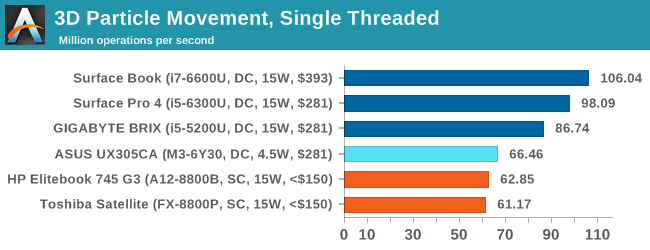
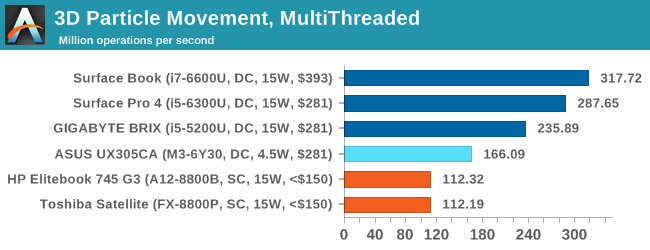
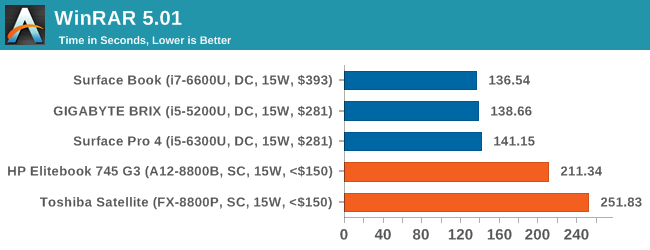

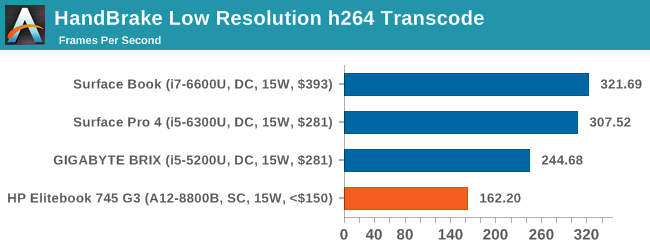

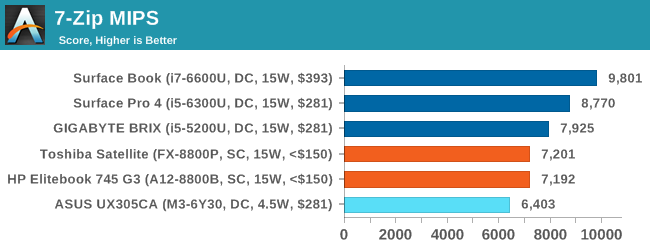
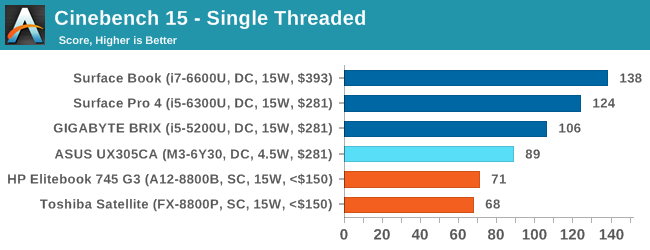
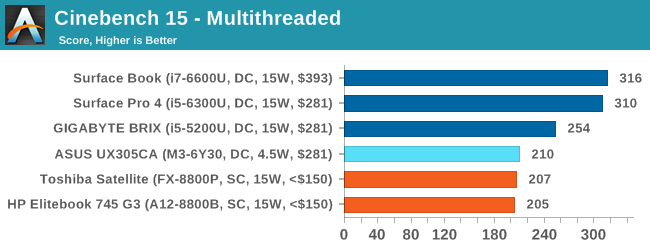
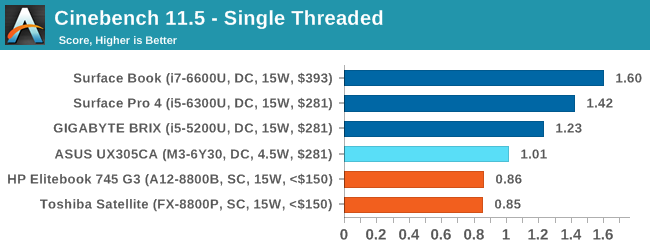


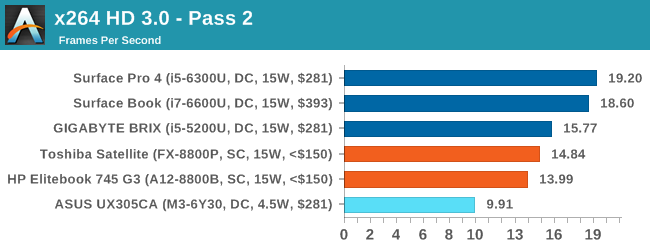
Most tests in this case favor the Intel 15W parts, with only POV-Ray being a fully multi-threaded integer workload pushing over the Broadwell i5-5200U. Ultimately this points to where Carrizo lies in performance: somewhere between Core M and Core i5, and it can sometimes lose to both in single threaded performance.
On the GPU and OpenCL tests:
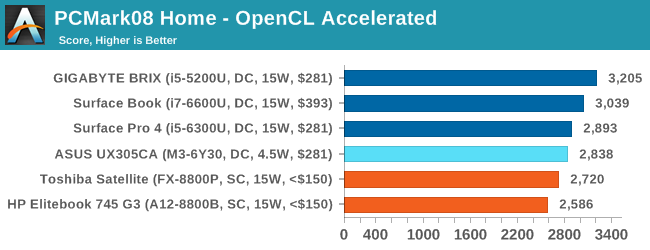
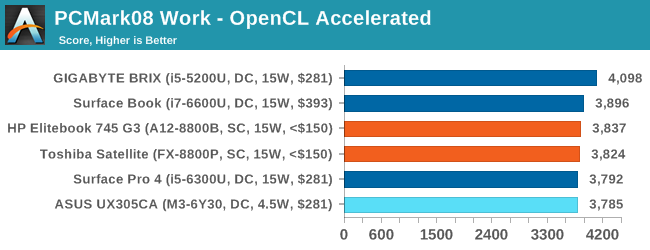

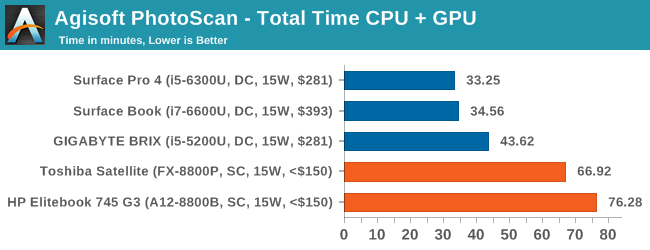
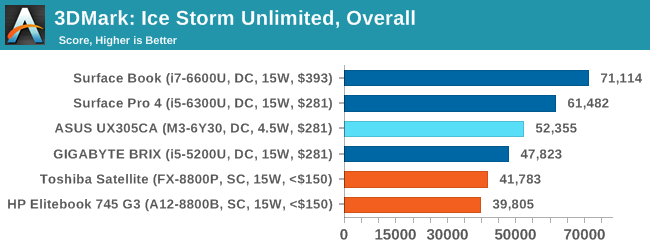

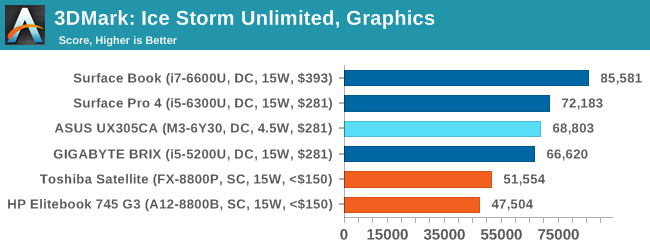

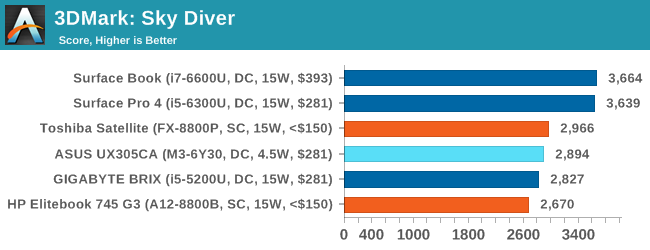
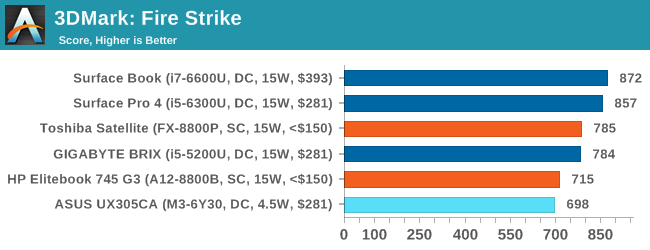
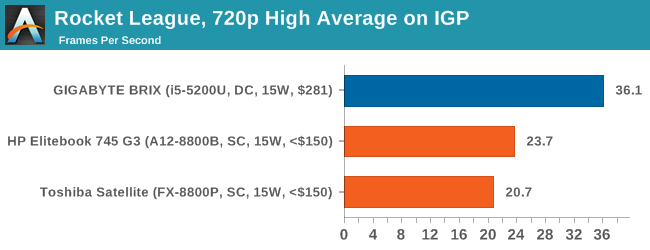
One of AMD’s big pushes is with gaming, OpenCL, and their Heterogeneous System Architecture (HSA). With all three markets, AMD wants to beat Intel. But here we have an issue – both of the AMD parts we have tested here are by default equipped with single channel memory, and may not even be dual channel capable if they share a device design with Carrizo-L (more on this in the next couple of pages). The use of single channel memory when Carrizo systems are sold essentially chokes the key parts of AMD’s offering.
A number of users might think it's unfair to show the results of two single channel Carrizo systems against dual channel Broadwell/Skylake systems, and we totally get that. After speaking internally with other editors however, we came across the situation that many Intel laptops come with dual channel memory as standard or a fixed memory arrangement to begin with. Looking at it closer, there is somewhat of a pattern:
| AMD Carrizo vs Intel Core Current Laptop Designs on the Market |
|||||||
| Name | Lenovo Y700-15ACZ |
HP Elitebook 745 G3 | HP Elitebook 840 G3 | Dell XPS 13 |
ASUS Zenbook UX303 | HP Envy 13t |
|
| Size | 15.6" | 14" | 14" | 13.3" | 13.3" | 13.3" | |
| Resolution | 1080p | 1080p | 1080p | 1080p | 1080p | 1800p | |
| Touch | No | No | No | No | Yes | No | |
| SoC | FX-8800P | A12-8800B | i5-6200U | i5-6200U | i5-6200U | i7-6500U | |
| µArch | Carrizo | Carrizo | Skylake | Skylake | Skylake | Skylake | |
| Integrated GPU | R7 512 SPs |
R7 512 SPs |
HD 520 24 EUs |
HD 520 24 EUs |
HD 520 24 EUs |
HD 520 24 EUs |
|
| Discrete GPU | R9-M380 4GB | - | - | - | - | - | |
| TDP | 35W+? | 15W | 15W | 15W | 15W | 15W | |
| Memory | 1x8GB DDR3L 1600 |
1x4GB DDR3L 1600 |
2x4GB DDR4 2133 |
2x4GB LPDDR3 1866 |
2x4GB DDR3L 1600 |
2x4GB DDR3L 1600 |
|
| Memory Channels |
Single Only |
Single / Dual |
Dual | Dual | Dual | Dual | |
| Storage | 1TB 5400 RPM | 256GB SSD |
128GB SSD |
128GB PCIe | 256GB SSD |
512GB SSD |
|
| Battery Size | 60 Wh | 45.76 Wh > 8.5h |
45.76 Wh | 56 Wh | 50 Wh > 7h |
45.76 Wh > 7.5h |
|
| Weight | 5.72 lbs | 3.41 lb | 3.41 lb | 2.7 lbs | 3.2 lbs | 3 lbs | |
| OS | Win10 Home | Win10/7 Pro |
Win7 Pro |
Win10 Pro | Win10 Home |
Win10 Home | |
| Warranty | 1Yr Base | 3Yr Parts 3Yr Labor |
1Yr Parts 1Yr Labor |
1 Year | 1 Year | 1 Year | |
| Price | £799 / $972 | $1049 | $1149 | $1049 | $899 | $1050 | |
After doing research for that table, there’s a clear relationship between the nature and style of the device. In each circumstance, the default Carrizo arrangement had only single channel memory whereas each Intel device came with dual channel as standard. Part of this is down to cutting costs, while part of it comes to the Carrizo/Carrizo-L shared design in the case of the Lenovo Y700. In each case, the system is being un-necessarily cut off from available performance due to choices at the point of product inception.
With that being said, there are some Intel designs that specifications wise do knock it out of the park. If there’s willing to be compromise a bit on the styling or warranty around this price point, then at the same price as the Elitebook G3 there can be an i7-6500U and a QHD+ display through the HP Envy 13t. But in each other case where the Intel system gets dual channel memory there’s also either a smaller drive or a more restrictive warranty on the Intel system. Or in the case of the Carrizo based Lenovo Y700, under $1000 gets a discrete graphics card, the 35W version of the APU, but it’s still limited to single channel memory by design, which is frustrating.
The situation looks a bit worse if we do a direct comparison between two equivalent price Lenovo Y700 systems:
| AMD Carrizo vs Intel Core Lenovo Ideapad Y700 15.6-inch |
|||
| Name | Lenovo Y700-15ACZ | Lenovo Y700-15 | |
| Visual | |||
| Size | 15.6" 1080p IPS | 15.6" 1080p IPS | |
| Touch | No | No | |
| Processor | AMD FX-8800P (35W) 2M/4T, 2.1-3.4 GHz |
Core i5-6300HQ (45W) 4C/4T, 2.3-3.2 GHz |
|
| Graphics | R6 + R9-M380 4GB | HD 530 + GTX 960M | |
| TDP | 35W + ? | 45W + 65W | |
| Memory | 1 x 8GB DDR3L-1600 Single Channel |
2 x 4GB DDR4-2133 Dual Channel |
|
| Storage | 1 TB 5400 RPM | 500 GB 5400 RPM | |
| Battery | 60 Wh | 60 Wh | |
| WiFi | 'Lenovo AC' | Intel 3165 802.11ac 1x1 | |
| Dimensions | 15.24 x 10.91 x 1.02" | 15.24 x 10.91 x 1.02" | |
| Weight | 5.72 lbs | 5.72 lbs | |
| Webcam | 1280x720 | 1280x720 | |
| OS | Windows 10 Home | Windows 10 Home | |
| Warranty | 1 Year | 1 Year | |
| Price | £799 / $972 | $980 | |
Here are the two Lenovo Y700 models at the same price, one with AMD and the other with Intel. The Intel part has a quad core i5 with a 45W TDP, a GTX 960M for graphics (similar in GFLOPS to the R9 M380) and dual channel memory. The models should compete similarly in gaming at 1080p, but if the AMD system allowed dual channel and CrossFire between the integrated APU and the discrete card it would handily get a boost. DirectX 12 might help here, if it can use both cards depending on the firmware, but at this point the positive for AMD over Intel is the larger hard disk. The Intel model has single stream 802.11ac wireless, which can be upgraded for $20, whereas the AMD wireless is not specified.
There’s no sugar coating the fact that there is a deficit in performance per watt between AMD’s best and Intel’s best in this regard, due to both the architecture and the process node. The price/performance ratio is a little bit trickier to digest, especially when so few AMD designs are by default equipped with enough memory and it can limit the maximum platform performance. In the case of the Y700 above, it’s because the product shares a platform with Carrizo-L making it limited to single channel memory, although I can't exactly find a Carrizo-L APU in a Y700 on the market.
Additional February 10th:
Since the publication of the review, a couple of things have come to our attention. Our pre-production Lenovo Y700, with both memory slots populated, was performing in single channel mode although our source for this sample assumed it was dual channel. Our testing confirmed single channel. However, the full retail version of the Y700 has an updated motherboard design to enable dual channel operation when both memory slots are populated with compatible memory. As far as well can tell, all Carrizo Y700 units at retail should be able to support dual channel memory.


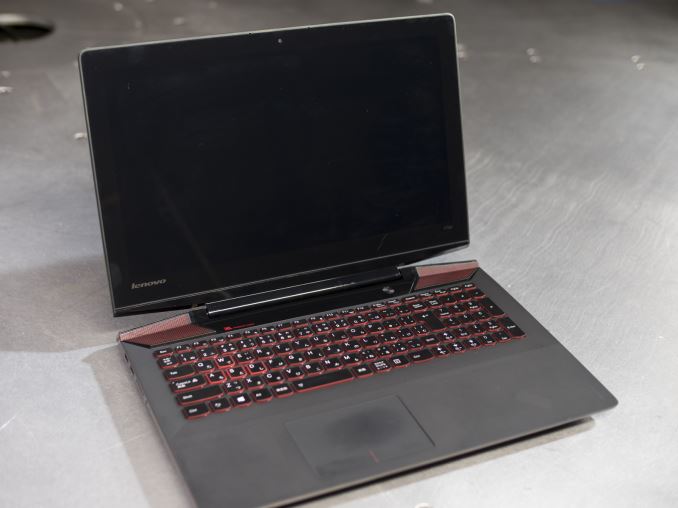
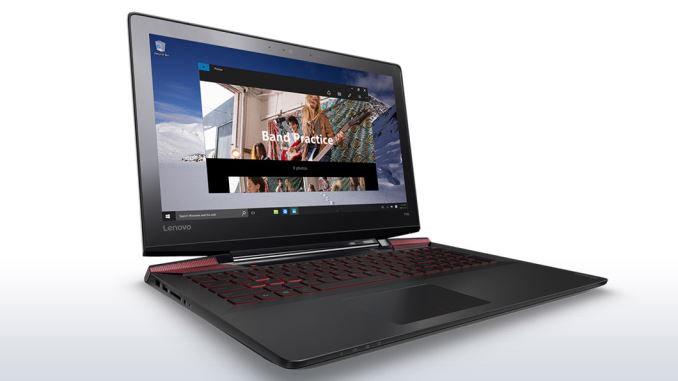








175 Comments
View All Comments
Danvelopment - Monday, February 8, 2016 - link
Strategy AMD should adopt:90% of people don't notice a performance difference above 3000 Super CPU Points, Intel CPUs are usually 4000-8000 Super CPU points, our chips may only range from 3500-4500 Super CPU Points but regular users won't actually notice it, and at the same performance marks we're a hundred dollars cheaper. Make the sensible choice.
Another way, we've done extensive testing to see what end users want and need, then we targeted those sectors, and where we matched Intel we made sure we were a hundred bucks cheaper on the same devices.
"We don't hold the performance crown but the price/performance crown"
Marcelo Viana - Monday, February 8, 2016 - link
Dammit, the solution should be simple, but must come from AMD, since can't expect it from oem's and all of them offer let's say 2011 sockets as example, why amd do not develop a socket switch, so a small board with 2011 pins on the bottom and a circuit on this boad to give a whatever socket amd choose connections on top of it, in order to accept amd chips.But AMD must understand that the memory on their chips must be ddr4(Carrizo do), because the lazy OEMs whon't change memory sockets, as example.
In this case the lazy ones have only to change the chip, and even better if any consumer have a old machine can upgrade to a chip that they choose. simple as that.
Anyone that sales more creates the standard on the market, the others is that must follow.
So who control the user experience? I think no one. everyone in the process just looking to explore the users in order to get money nothing more, but if i have to guess, problably the users. Because they are the one that really have the power to say "i won't buy it or that' or even better "until they give to me what i want" just my 2 cents.
farmergann - Tuesday, February 9, 2016 - link
Seems like you missed out on some highlights of the Y700. The memory is dual channel, the IPS screen has Freesync, and the sound is surprisingly awesome. Replaced the HDD with a Samsung 850 Pro and have thoroughly enjoyed it since.bitech - Tuesday, February 9, 2016 - link
Lol have they never seen a 17" laptop before? The HP Pavilion has a 1600x900 because it's 17". 1600x900 is the minimum resolution on all 17" laptops, not 1366x768.UtilityMax - Wednesday, February 10, 2016 - link
1600x900 is still a crappy resolution for such a large screen. I had a notebook with 15.5 inch 900p screen, and it was visibly grainy.mosu - Tuesday, February 9, 2016 - link
Just few words: Sabotage and corruption at high level OEM decision level. Simple as that.Arief Sujadmika - Wednesday, February 10, 2016 - link
AMD just need a feature to turn off the chips if its detect single channel memory for Carrizo then the OEM will make dual channel memory for it...thatthing - Wednesday, February 10, 2016 - link
the y700 r9 385x is a bonaire gpu, amd has no 512sp chips mobile r9 series, http://www.amd.com/en-us/products/graphics/noteboo...silverblue - Wednesday, February 10, 2016 - link
Articles like these make me want to see how good the unrestricted Athlon X4 845 will be, however as it's probably defective Carrizo silicon, I wouldn't expect it to be massively frugal. I do wonder if there will be any Bristol Ridge Athlons; the top models are rated with a cTDP of 25-45W which is a decent improvement and would reduce/eliminate throttling. Overclocking may not help in terms of power but performance would be more consistent. You also get DDR4 which isn't as big a help for the Athlons but it would be interesting to see the difference.A review of the Dell Inspiron I3656-7800BLK would be a good marker, if only to show the maximum performance of the mobile chips.
Masospaghetti - Wednesday, February 10, 2016 - link
Seems like the best configuration of a Carrizo machine would be a 35w TDP A12 with dual channel memory and integrated graphics (or discrete graphics with crossfire enabled).It's a shame that all of the machines available are severely compromised with either single channel memory, 15w TDP, lack of crossfire, or a combination of these. Seriously. The machines tested have terrible designs. Looks like AMD made a huge mistake providing a common configuration with Carrizo-L with the single channel memory.